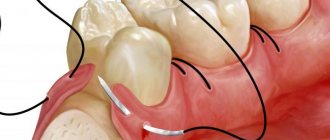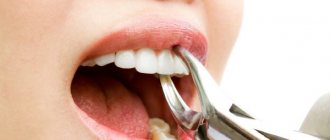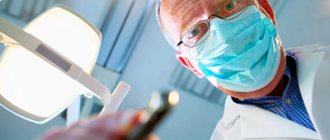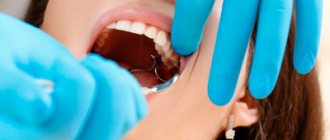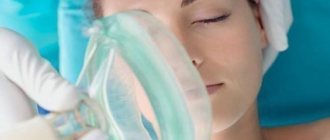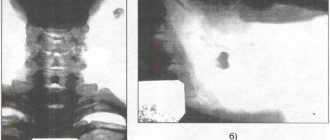22.11.2019
The outermost teeth in a row cause a lot of trouble for many people. By getting rid of them, a person expects relief, but pain often appears in neighboring, seemingly healthy teeth. In some cases, these are simply the consequences of a complex operation, while in others they are the beginning of an infectious-inflammatory process and the development of other complications.
Content:
- What to do before deleting the eight
- What happens in the oral cavity during the extraction of the eighth tooth?
- What to do after wisdom tooth removal 3.1. The first day after removal 3.2. Second day after pulling out figure eight 3.3. Third and fourth days after wisdom tooth removal 3.4. A week after wisdom tooth removal 3.5. A month later
After a wisdom tooth is removed, the socket often becomes infected. Because of this, severe swelling forms and the tissues become inflamed. To exclude the development of negative complications, you need to properly prepare for surgery and follow all medical recommendations after it.
Complex removal of an upper wisdom tooth
As part of this procedure, drills are used, and the gingival tissue is dissected and the dental socket is sutured. Swelling after such removal of the upper wisdom tooth is considered a normal manifestation. The reason for this operation is the eruption of the tooth in a horizontal position, under a layer of bone tissue.
Procedure steps:
- Initially, the site of future intervention is anesthetized.
- The gum is dissected and part of it is peeled off using a scalpel.
- A hole is created in the bone tissue. In this case, special tips and cutters are used to provide a cooling effect.
- Full or partial extraction is performed.
- The dental alveolus is thoroughly washed with an antiseptic solution.
- The bone wound undergoes plastic surgery, and the detached part of the gum is returned to its place.
- Suturing the alveolar cavity and stopping bleeding.
After implementing all the sequential steps and removing the upper wisdom tooth, the specialist makes recommendations regarding further care.
What to do before deleting the eight
There are a number of rules to make surgery safer and reduce the risk of postoperative complications. Among them:
- Eat one to three hours before visiting the dentist (but if general anesthesia is planned, you cannot eat!). A preliminary meal before extraction, performed under local anesthesia, promotes better blood clotting and improves the patient’s physical condition.
- Carry out removal in the first half of the day (preferably in the morning). In the morning hours, the human body copes better with stressful situations. In addition, if the procedure is scheduled for the evening, the patient may experience insomnia due to persistent pain and nervous tension.
- Do not drink alcoholic beverages on the eve of surgery. They negatively affect the rheological properties of blood, which means that the risk of swelling and bleeding will increase.
- In case of severe anxiety, take a sedative of herbal origin. It is important that the person is not allergic to the drug used.
To remove the figure eight, you need to choose a clinic and a dental surgeon whose reputation is beyond doubt. Then the patient will be able to relax better, which means the procedure will be more comfortable.
Is it painful to remove a wisdom tooth in the upper jaw?
According to many dental visitors, they are afraid of pain during the extraction procedure of the upper eighth teeth. Fortunately, today powerful anesthetic drugs have been developed that can relieve pain.
As a rule, patients report discomfort after surgery. This is due to the cessation of the action of painkillers. To get rid of unwanted complications after removal of the upper wisdom tooth during the recovery period after surgery, the specialist additionally prescribes anti-inflammatory and anesthetic agents.
At the Elident clinic, experienced surgeons with 25 years of experience will work with you, who use modern instruments in their work, regularly carry out interventions related to the extraction of “eights” and use effective methods of anesthesia. This guarantees increased comfort during the procedure and eliminates complications after it. In addition, we provide important recommendations that must be followed after the removal of the upper wisdom tooth in order to avoid unwanted manifestations in the future.
What happens in the oral cavity during the extraction of the eighth tooth?
When deciding how to treat a particular patient, the doctor takes into account the characteristics of his physical and emotional state. Particular attention is paid to the presence of allergies to medications.
If there are no contraindications to extraction, the doctor administers an anesthetic. When the area becomes insensitive, the gum bends back and grabs the wisdom tooth with forceps. Begins to make rocking movements, allowing you to loosen the periodontal connection and extract the diseased tooth.
Since during the operation the vessels through which blood flows to the pulp tissues are damaged, bleeding occurs. Nerve impulses indicating trauma are transmitted to the brain. Then pain appears. But due to the action of the anesthetic, the patient does not feel it at first.
The hole formed as a result of the operation is heavily supplied with blood. Leukocytes rush here. Swelling occurs and inflammation develops.
Immediately after surgery, the doctor closes the wound with a sterile cotton swab. It helps stop bleeding and creates conditions for the formation of a dense blood clot. The latter is needed to prevent the penetration of pathogenic microorganisms into the tissues of the wound surface. Do not remove the tampon before the doctor says!
Removal of a completely destroyed upper wisdom tooth
If a patient has a completely destroyed wisdom tooth, removal of the upper molar becomes inevitable, since it becomes painful for the person to chew food. Unfortunately, not every specialist can cope with such a situation. Sometimes the “eight” has to be removed in parts, which requires a significant investment of time and painstaking work of an experienced surgeon.
First of all, this is due to the difficulties that arise when trying to fix a tooth with forceps. In this case, it may be necessary to dissect the gum tissue. In particularly difficult situations, it may be necessary not only to crush hard tissue, but also to saw through the bone in order to free access to the root part of the tooth.
Such surgical intervention is best performed in patients no younger than 40 years of age, since it is during this period that the alveolus undergoes atrophy.
What to do after wisdom tooth removal
The eighth units, located on the upper jaw, are removed less painfully. The lower jaw bone is denser. It includes an extensive root system. Therefore, the lower eights are usually more difficult to pull out.
To avoid problems during regeneration, you should properly care for the hole. The most important thing is to prevent the proliferation of pathogenic microorganisms inside it. After removing the 8th tooth, you should never:
- make suction movements from the hole (they lead to detachment of the blood clot);
- chew food on the side where the wound is located;
- rinse the hole intensively with antiseptics;
- take medications that were not prescribed by a doctor.
The first day after removal
After about half an hour, you are allowed to remove the tampon covering the wound. It is important to do this exactly when the doctor who performed the operation tells you to.
In case of severe pain, you are allowed to take a painkiller. Doctors usually recommend non-steroidal anti-inflammatory drugs based on nimesulide.
In the first three hours after extraction, you should not eat anything or drink hot drinks. It is important to exclude active facial expressions, as this may cause bleeding. It is advisable to sleep on the side of the extracted tooth.
Second day after pulling out the figure eight
The patient is bothered by pain. Body temperature may rise to 38 degrees. To reduce discomfort, you can take NSAIDs and apply cold compresses.
On the second day after surgery, it is advisable to eat soft foods - porridge, soups, broths. Food must be warm and at room temperature. Never cold or hot. The patient will have to give up spicy, sweet, very salty and sour foods.
You should take medications prescribed by your dentist. Rinsing is not recommended, as it may help flush out the blood clot.
Third and fourth days after wisdom tooth removal
These days, granulation tissue begins to actively form. It is from this that new epithelium is formed in the future. As prescribed by the doctor, the patient can rinse with antiseptics.
Typically, pain decreases at this stage of regeneration, so there is no need to take analgesics or NSAIDs.
One week after wisdom tooth removal
Seven days after surgery to remove a wisdom tooth, the socket is completely covered with new connective tissue. A healthy epithelium forms on its surface. If the body temperature does not increase, the swelling has passed, which means that healing is proceeding without complications.
The patient still needs to abstain from eating solid foods. Food should not be cold or hot. It is important to take good care of your mouth and not skip routine dental checkups.
Anesthesia for removal of the upper wisdom tooth
As a rule, before extracting the “eight”, they resort to local painkillers - injections with articaine, lidocaine and other drugs with a similar spectrum of action. The dentist makes 2 injections - from the side of the palate and on the outside of the upper jaw. This allows you to obtain a powerful anesthetic effect, which manifests itself within 2-5 minutes after administration.
In the case of the eighth tooth, located in the mandibular region, at least 9-10 minutes are required due to the increased bone density in this area.
However, the pain syndrome can make itself felt within 2-3 hours after surgery, which requires additional use of painkillers and anti-inflammatory drugs.
Recommendations for recovery after removal of the upper wisdom tooth
After extraction of the upper wisdom tooth, at least 1-2 days are required for the patient’s rehabilitation. In some cases, this period may be delayed. To avoid complications, you must adhere to the following recommendations:
- Use antibacterial therapy prescribed by a specialist, as well as drugs that relieve inflammation and pain;
- Refuse to visit the sauna, swimming pool and bathhouse - in order to eliminate the possibility of wound infection;
- In the first days after the intervention, it is recommended to use soft products;
- If possible, stop using tobacco products.
We employ specialists of the highest category, which eliminates the possibility of making any mistakes during the procedure and guarantees a shortened and easy recovery period.
